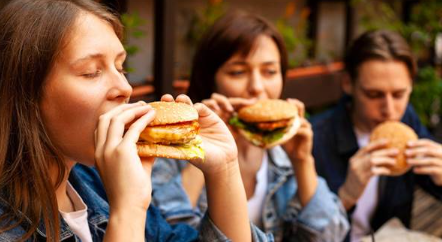Why Fast Food Is So Irresistible—Even When We Know Better
The fast-food sector in the Philippines is massive. Filipinos consume over USD 7 billion (PHP 395.57 billion) of fast food yearly. It’s estimated that 50% of Filipinos eat fast food at least twice a week.
So why is fried chicken from Chowking or a burger from Jollibee more enticing than a steak and salad at Antonio’s?
Let’s unpack the psychology behind choosing fast food and decide whether it’s as bad for us as we’re made to believe.
Why Do We Choose Fast Food in the First Place?
When it’s time to eat, we generally have three choices: cook at home, go to a fine dining restaurant (or at least a nicer one), or visit a fast-food place. Why is the latter so appealing? Let’s dig deeper.
Affordability
Many of us view fast food as the most budget-friendly option, and we’re right. Even going to the supermarket and buying ingredients, then adding in labor, feels more expensive.
While fast food isn’t always cheap, especially nowadays, it can become a lot more affordable via promotions. Daily and weekly discount offers, points programs, and options like combo meals help us save more per visit.
Loyalty programs are also a clever way for fast food chains to keep us coming back.
Emotional Comfort
As busy Filipinos, we often feel tired and stressed, and fast food has a way of boosting our emotions. There’s a legitimate reason why: fast food is specifically formulated to create a “bliss point”—the ideal amount of sugar, fat, and salt—which then encourages our brains to release dopamine, making us feel happier. At least temporarily.
Our bodies remember this, so what do we do the next time we’re feeling a bit low? We head to Chowking and grab a Dimsum mix platter. The instant gratification is worth it.
The Social Aspect
We Filipinos are a social bunch, and as such, we love to share meals. Forty percent of all fast-food meals consumed in the Philippines are dine-in. Meeting up at a fast-food restaurant just makes sense: they’re everywhere, fit into most people’s budgets, and the menus are varied enough that there’s something for every type of eater.
Eating fast food is also encouraged in peer groups. To fit in, we may need to follow the crowd. If everyone else is eating fast food, it makes sense to join in.
Convenience
What’s easier? Going to the supermarket and hunting down everything on your list? Sitting down at a fine-dining restaurant and waiting to be served? Or pulling out the GrabFood app and ordering some fried chicken? Most of us are probably going to take option three—that’s why fast food is the most convenient meal choice. With branches everywhere, it’s easy to drop in on the way home from work for takeout or head out to one nearby.
Convenience is a significant reason why we do many things. We take the train instead of driving, as parking can be a nightmare. Instead of battling mall crowds, we order in. We even use our smartphones to play at the best VIP online casinos instead of heading to the land-based ones.
Marketing
Beyond affordability, emotional appeal, social norms, and convenience, marketing is perhaps the biggest invisible influence. Around USD 600 million (PHP 33.9 billion) is spent annually on marketing fast food in the Philippines. That’s a massive outlay—and guess what? It works. If we’re spending USD 7 billion on eating out, then the companies are getting their money back, in excess.
Catchy jingles, celebrity endorsements, and social media are all ways that fast food chain marketers get our attention. This activity works subliminally, so when we’re hungry, we remember the ads, and off we go.
Is Fast Food Really That Bad for Us?
Of course, with all this love for fast food, the health question inevitably comes up: is it really that bad that I’m eating this? There are two sides to this coin:
Okay, It’s Bad
Doctors and nutritionists warn about regularly eating fast food as it may cause these conditions:
- obesity
- type 2 diabetes
- metabolic syndrome
- cardiovascular disease
- insulin resistance
Also, in many fast-food meals, there isn’t much nutritional value. They’re usually low in fiber, vitamins, and essential micronutrients.
But It Doesn’t Have to Be
While health experts would like you to believe that eating fast food is the worst thing you can do to your body, you can eat it. Here’s how to make smarter choices:
- Eat fast food occasionally: If you’re like the majority of Filipinos who eat fast food twice a week, those sudden spikes in calories, sugar, and fat probably aren’t doing you that much harm.
- Make mindful choices: If you add salads, choose sugar-free drinks, and don’t upsize, you’re still treating yourself, but doing it healthier.
There are other reasons why occasionally choosing fast food works for us:
- Psychological and social benefits: We talked about this in the section above. In small quantities, fast food can increase our mental and emotional well-being.
- Lifestyle reality: Let’s face it—we’re all busy; sometimes the only way we can fit a meal in is to grab fast food. As long as it’s not every meal, it can still have a place in our lives.
- Improvements in fast food quality: Readers will be glad to know that many fast-food chains are using their R&D departments to come up with healthier ways to store and prepare their meals. This change has come about partly in response to consumer demand for healthier options.
Fast Food Is Irresistible, and That’s Not Likely to Change
Now you understand why we keep coming back to fast food: it’s convenient, affordable, socially acceptable, and it makes us feel good. Sure, in large doses, it can be harmful, but with savvy choices and the occasional indulgence, it’s not the end of the world. Wanton noodles, anyone?







